By William C. Peters
Recently, an engine company’s apparatus responding to a fire call in a large city went out of control and struck a parked police car head-on when the driver attempted a panic stop to avoid a collision with another car. The police officer was hospitalized, and one firefighter suffered a broken arm in the collision. The driver reported that the air brake-equipped pumper pulled hard to the left when he applied the brakes.
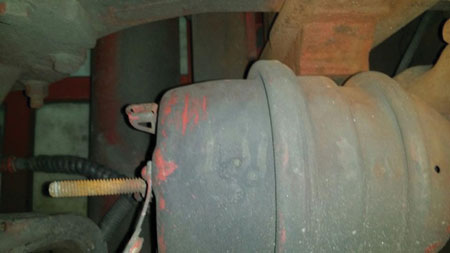 |
| (1) The threaded bolt sticking out of the rear of the brake canister is a caging tool used to manually release the spring parking brake. (Photos courtesy of author.) |
Two brake-related equipment issues were discovered after the accident. First, as reported by a news outlet on the Internet, the engine company’s daily log had the notations “Air leak and valve bracket” and “Was advised foreman will advise when to come down.” Second, one of the rear brake chambers had the parking brake spring “caged”; this is a procedure in which a threaded tool is inserted into the rear of the chamber to capture the powerful spring that applies the parking brake either when the air pressure is depleted or when the parking brake is applied. This is typically done when the vehicle is towed; however, the engine in question hadn’t been towed for several months. The question becomes, how long has the parking/emergency brake on that wheel been disabled (photo 1)? It is unlikely that this contributed to the accident, but it could have had serious consequences if the apparatus was parked on a steep hill or if a catastrophic air leak activated the emergency braking system.
Who Is Responsible for Apparatus Maintenance?
You, the driver. Whether your title is engineer, chauffer, driver, or apparatus operator, the first level of responsibility rests with you. The apparatus needs to be inspected at the beginning of the shift, or possibly weekly in a volunteer organization, to ensure that the vehicle is roadworthy and ready to perform at a moment’s notice. If any defect is noted, the information must be provided to the company commander. Company commander. It is the responsibility of the company commander to document the problem and notify the proper authority that repairs are needed, whether by the shop or an outside repair facility. If the deficiency is severe enough, the apparatus should be placed out of service until repairs can be made. Many times, members are reluctant to place the apparatus out of service because it requires them to change over to a spare apparatus that might be in worse condition than the rig that needs to go to the shop! Depending on the department, all hose and equipment might need to be transferred over to the spare, which is labor intensive. In volunteer departments, a spare might not be available, and members might be reluctant to give up their only piece of apparatus. Nevertheless, an unsafe apparatus must not remain in service, especially when safety or operational deficiencies are documented.
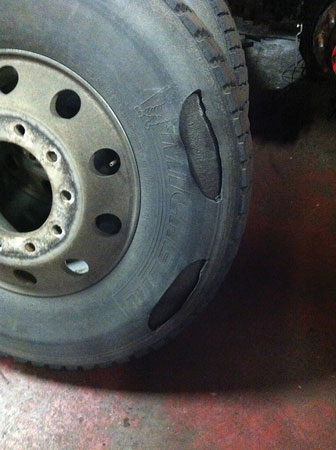 |
| (2) Tires with sidewall cuts that penetrate to the cord are cause to place the apparatus out of service. |
A number of years ago in Texas, an aerial apparatus that was equipped with a pump and tank arrived first-due at a working house fire with children trapped. Unfortunately, the water tank developed a leak, and a decision was made to leave the truck in service for its aerial equipment and ground ladder complement. Several children died in that fire, and the fire department was held responsible for leaving the defective vehicle in service.
The shop or repair facility should provide guidance to the company commander as to whether the apparatus needs to be placed out of service or can safely be operated until it can be repaired. If there is any doubt, the apparatus should be placed off-duty until it can be inspected and a final determination made.
 |
| (3) Badly worn tires need to be replaced. |
Fire department administration. The fire department administration should establish a maintenance program that includes out-of-service criteria as outlined in National Fire Protection Association (NFPA) 1911, Standard for the Inspection, Maintenance, Testing and Retirement of In-Service Automotive Fire Apparatus (2012 Edition). In addition, the administration must ensure that the operators have the knowledge and tools to properly inspect and document any apparatus deficiencies. A good basic daily/weekly walk-around check form for mobile fire apparatus is in NFPA 1911, Annex C.
Driver/operator training is also the department administration’s responsibility. This includes a full understanding of how air brake-equipped vehicles differ from a typical car or pickup truck. As I wrote in the Fire Engineering June 2015 Apparatus Supplement, I think that states that exempt firefighters from the commercial driver’s license (CDL) requirements are doing a disservice to the public and the fire service. The air brake-related knowledge contained in the CDL program might just save someone’s life.
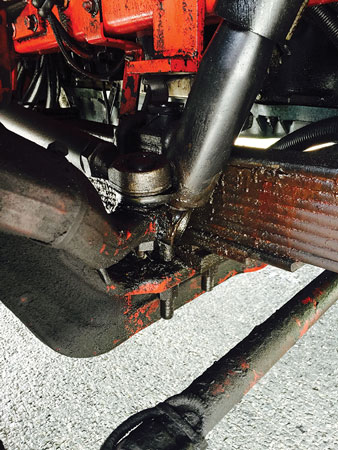 |
| (4) This broken shock absorber jammed the steering linkage on a pumper. |
Many years ago in the Jersey City (NJ) Fire Department, an example occurred of how unfamiliarity with the air brake system on a borrowed piece of apparatus proved to be detrimental. The vehicle, a heavy single (rear) axle tower ladder, was responding as the first-due truck to a confirmed structure fire. As the chauffer responded on the main street with the siren and air horns cranked up, he failed to identify the low-air warning alarm in the cab. As he approached the side street that the fire was located on, the truck was unable to slow down enough at the corner to make the turn. The chauffer had to stop and back up, make the turn, then respond down the block. Without consideration of how difficult it was to stop the heavy vehicle on the turn, he continued into the scene at normal speed, applied the brakes, and crashed into the rear of the first-due pumper that was fighting the fire! Fortunately, no one was injured in this accident, and the fire was contained. Our neighboring community, which lent us the truck, was not thrilled with the damage, but the city covered the expense of the repairs. In the accident report, the driver stated that with the sound of the siren and use of the air horns, he did not notice the low-air warning and was unaware of the truck’s reduced braking capacity.
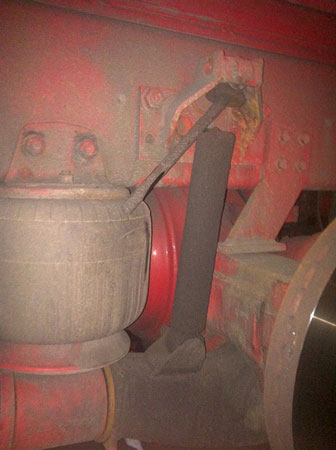 |
| (5) The shaft of a broken rear shock absorber nearly punctured the air-ride suspension. |
Out-of-Service Criteria
NFPA 1911 provides an outline of the criteria that the authority having jurisdiction (AHJ) can use to formulate a standard operating procedure (SOP) for determining when a unit should be placed out of service.
When the operator identifies defects, a qualified technician should evaluate the problem and report to the AHJ if the apparatus needs to be immediately taken out of service, can be retained in service with certain limitations, or can be retained in service without limitations. In addition to the items described in the standard, any violation of Department of Transportation (DOT), state, or local regulations or the manufacturer’s recommendations should be cause for an out-of-service determination.
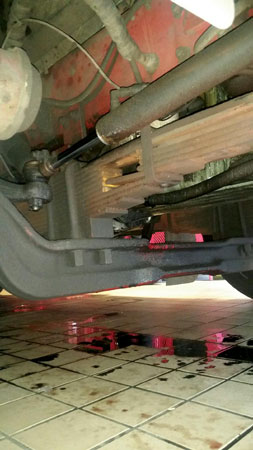 |
| (6) This front leaf spring pack is missing numerous pieces of the springs. |
- Driving and Crew Area, Apparatus Body
- Cracked or broken windshield obstructing the driver’s view.
- Missing or broken rearview mirrors that obstruct the driver’s view.
- Missing or broken windshield wipers.
- Missing or broken door latches.
- Missing or broken foot throttle.
- Broken or damaged seat belt (driver’s); others, take the seat out of service.
The following deficiencies are to be evaluated by a qualified technician:
- Body mounting.
- Cab mounting.
- Steering wheel.
- Required instrumentation.
- Defrosters.
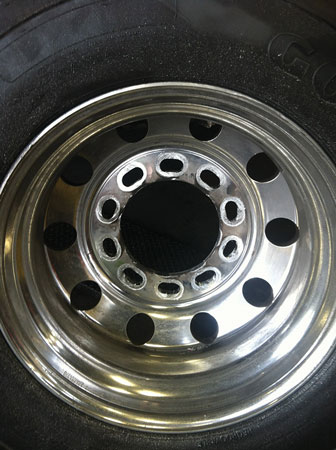 |
| (7) Elongated bolt holes in this wheel were caused by improperly torqued lug nuts. |
- Chassis, Axles, Steering and Suspension, Driveline, Wheels and Tires
- The gross axle weight rating exceeds the tire manufacturer’s load rating.
- The weight on the front or rear axles exceeds the gross vehicle weight rating label.
- Tires have sidewall cuts that penetrate the cord (photo 2).
- Tires have a tread depth less than 4/32 on any steering axle or 2/32 on any nonsteering axle (photo 3).
- Suspension components are loose, broken, or missing (photos, 4, 5, and 6).
- Wheels or rims have the following deficiencies:
- Bent, broken, or cracked lock rings.
- Cracked, broken, or elongated bolt holes (photos 7, 8).
- Loose, missing, broken, or stripped fasteners.
- Weld deficiencies.
- Axle flanges with leakage (photo 9).
- Steering components that do not meet the minimum inspection standards of the federal regulations.
- Steering components with leakage.
- Driveline components that don’t meet federal requirements.
- Tire deficiencies to be inspected by a technician include punctures, cuts to the cord, and bulges or bumps associated with tread sidewall separation (photo 10).
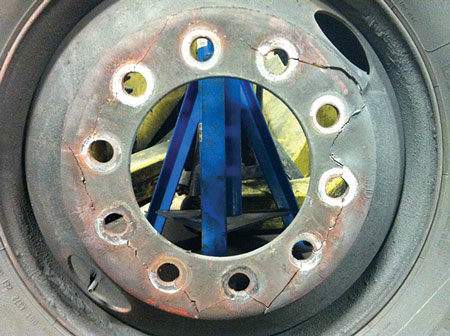 |
| (8) This wheel shows serious and dangerous cracking. |
- Engine Systems
- An engine that will not crank or start.
- A major oil leak (photo 11).
- An engine that is overheating.
- Engine oil that contains coolant.
- Oil that is diluted with fuel.
- Fuel system components with leaks.
- A “Stop Engine” light that fails to turn off with the engine running.
- Air filter restriction.
- Fuel tank mounting straps.
- Coolant leaks.
- Coolant that contains oil.
- A cooling system that exceeds the maximum operating temperature.
- Cooling deficiencies to be examined by a technician include the radiator, water pump bearing, cooling fan, and coolant system components (photo 12).
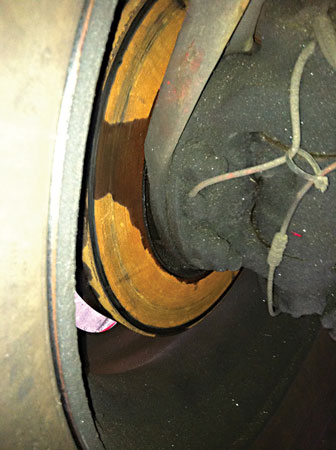 |
| (9) Axle lubricant leaking from a seal runs down the surface of this brake rotor. |
- Transmission and Clutch
- An automatic transmission that overheats.
- An automatic transmission that has a “Do Not Shift” light on.
- Transmission leakage.
- Transmission oil contaminated with coolant.
- The following system defects to be inspected by a technician include clutch components, transmission components, and shift linkages.
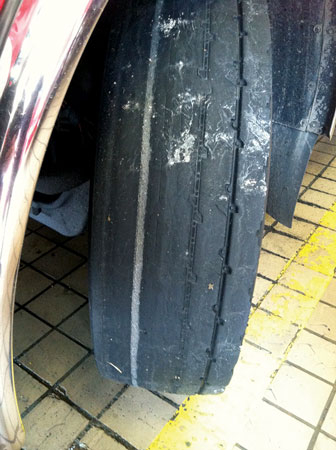 |
| (10) Tires worn to the cords indicate a serious condition. |
- Low Voltage and Line Voltage Electrical Systems
- A legally required DOT light or horn that is not operational (photo 13).
- An ignition system that is not operational.
- A charging system that is not operational.
- Failure of the warning light system that creates any position around the apparatus from which no warning light is visible.
- Grounding or bonding deficiencies.
- An inoperative siren.
- Overheating of the power source and systems.
- Tripping of circuit breakers.
- A line voltage power source producing high or low voltage.
- Damaged receptacles or observed electrical shock hazards.
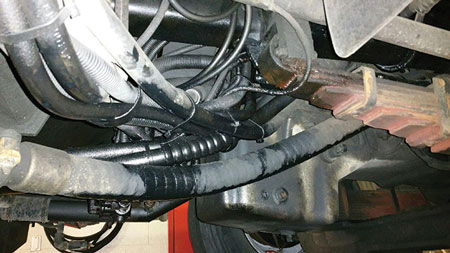 |
| (11) Oil and coolant leaks require immediate evaluation. |
- Braking Systems (Air and Hydraulic)/Air Brakes
- Service brakes that have an air pressure drop of more than two psi in one minute for straight chassis and three psi in one minute for combination chassis, with the engine stopped and the service brakes released.
- A leak down rate of the applied side of the air brake that is more than three psi in one minute and four psi in one minute for combination chassis with the engine stopped and the service brakes applied.
- Brakes that are out of adjustment.
- Braking components that are not operational.
- Service brakes that do not meet test or DOT requirements.
- A parking (spring) brake that does not meet test or DOT requirements.
- An air compressor that fails to build air pressure from 85 to 100 psi in 45 seconds with the engine at full throttle.
- An air compressor that fails to maintain 80 to 90 psi in the system with the service brakes applied and the engine at idle or a compressor that fails to fill the system to the governor cut-out pressure with the service and parking brakes released.
- Friction surfaces, brake shoes, or disc pads that have grease or oil on them.
- Brake linings or pads worn beyond the manufacturer’s recommendations (photos 14, 15).
- Rotors or drums that are worn beyond the manufacturer’s recommendations (photo 16).
- An air gauge or audio low-air warning device that failed.
 |
| (12) This engine cooling fan obviously came in contact with an immovable object! |
- Hydraulic Brakes
- Leaking brake fluid.
- Friction surfaces, brake shoes, or disc pads that have grease or oil on them.
- Brake system components that are not operational.
- Braking operation that does not meet braking tests or standards.
- Parking (service) brake operation that does not meet parking brake tests or standards.
- A brake warning light that is activated or a brake pedal that falls away or drifts toward the floor when pressure is applied.
- Brake linings or pads that are worn beyond the brake system manufacturer’s minimum specifications.
- Rotors and drums that are worn beyond the brake manufacturer’s minimum specifications.
- If the antilock braking system warning indicates a problem, have a qualified technician conduct an evaluation.
 |
| (13) Inspect and repair DOT vehicle lights. |
- Wheel Chocks
- If the apparatus is not equipped with two wheel chocks, report the condition to the AHJ.
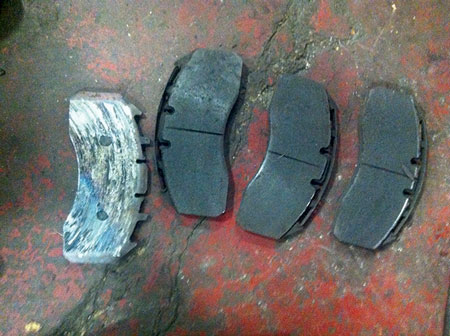 |
| (14) Three of the four disc brake pads shown are worn, but the one on the left has completely lost its lining and was stopping the vehicle with “metal on metal.” |
- Fire Pump System
- The pump will not engage.
- Pump shift indicators in the cab or on the pump panel are not functioning properly.
- The pressure control system is not operational.
- Pump transmission components are leaking.
- The pump panel throttle is not operational.
- The pump operator’s engine speed advancement interlock is not operational.
- Deficiencies to be evaluated by a technician include the pump transmission lubricant, valves, valve controls, pump piping, pressure indicating devices, water tank, and water tank level indicator.
- Pump shaft seals are leaking beyond the manufacturer’s recommendations.
- A failed pump test.
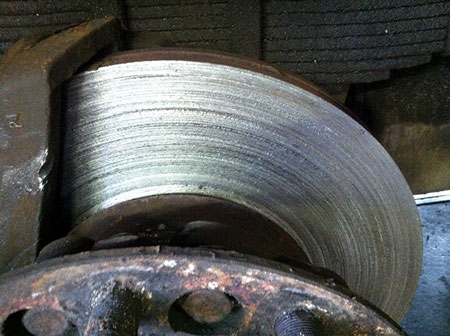 |
| (15) Driving with disc brake pads that are completely worn out causes serious scoring of the brake rotor. |
- Aerial Device Systems
- The power takeoff will not engage.
- The stabilizer system is not operational.
- The aerial device is not operational.
- Hydraulic system components are not operational.
- Cable sheaves are not operational.
- Cables are frayed.
- Base and section rails show ironing beyond the manufacturer’s recommendations
- An aerial device is structurally deformed.
- Torque box fasteners are broken or missing.
- Turntable fasteners are broken or missing.
- Deficiencies to be evaluated by a technician include the hydraulic relief valve, hydraulic system components, emergency hydraulic system, visual and audible alarms, aerial lighting, aerial intercom, labels or warning signs, and aerial water delivery system.
- A qualified technician should conduct an out-of-service evaluation on the following problems: rollers and slides worn beyond the manufacturer’s recommendations and rotation bearing that has clearances beyond the manufacturer’s recommendations.
It’s Up to You!
NFPA 1911 has a great deal of information about how various tests are to be conducted and blank forms for daily/weekly as well as quarterly inspections. In addition, testing criteria and performance forms for the pump, aerial, breathing air, foam, and electrical systems are all in the standard. I highly recommend that anyone who is involved with apparatus maintenance obtain a copy and follow the standard.
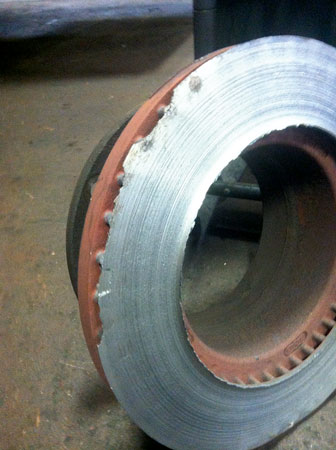 |
| (16) One side of this brake rotor is worn “paper thin.” This is generally caused by a defective caliper installation or a “metal on metal” brake pad condition. |
Finally, just like the terrorism watch words that we are told daily: “If you see something, say something.” I understand that apparatus drivers/operators are not mechanics, but you are the first line of defense in evaluating a problem with the apparatus. If something doesn’t sound right or feel right, report it, and let an expert do the evaluation. Your life as well as the lives of your fellow firefighters and the general public may be at risk!
WILLIAM C. PETERS retired after 28 years with the Jersey City (NJ) Fire Department, having served the last 17 years as battalion chief/supervisor of apparatus. He has served as a voting member of the NFPA 1901 apparatus committee for several years and is the author of the Fire Apparatus Purchasing Handbook, the apparatus chapters in The Fire Chief’s Handbook, and numerous apparatus-related articles. He is a member of the Fire Engineering and Fire Apparatus & Emergency Equipment editorial advisory boards and of the FDIC executive advisory board. He is the recipient of the FDIC International 2015 Tom Brennan Lifetime Achievement Award.
Fire Apparatus: Easy Steps for Aerial Maintenance
FACTORY INSPECTION TRIPS
WHO IS TRAINING YOUR APPARATUS DRIVERS?
Fire Engineering Archives

